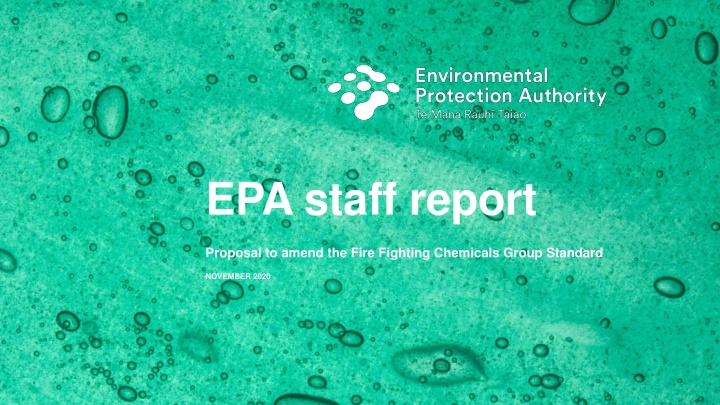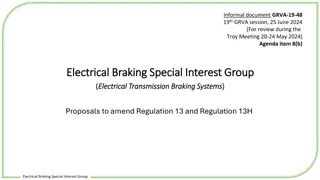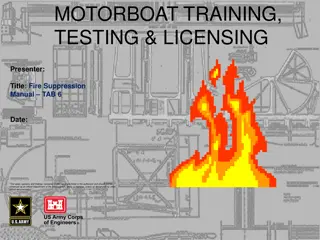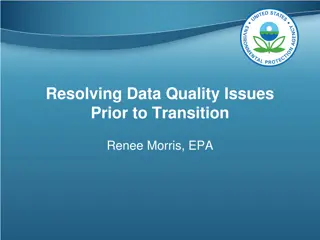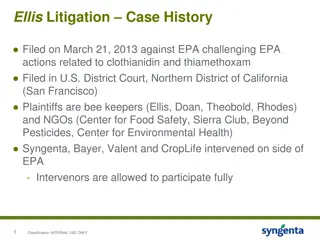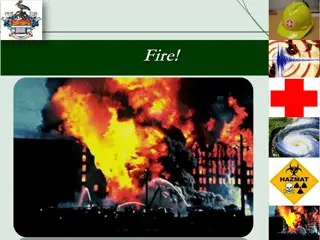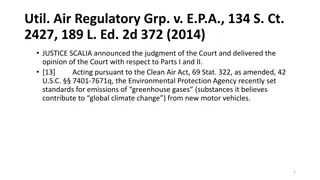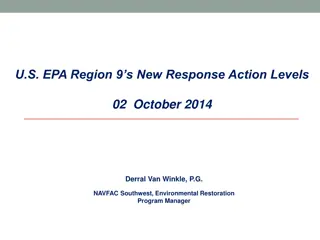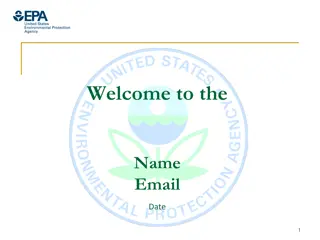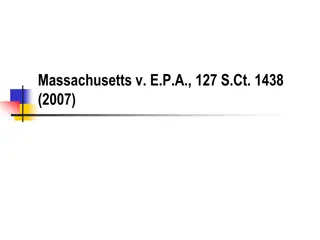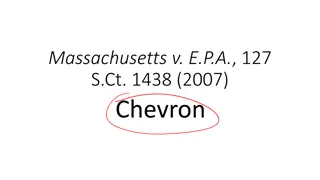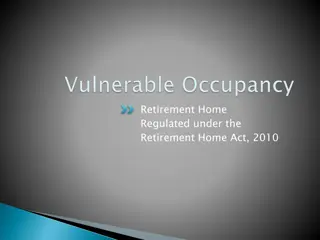EPA Staff Report Proposal to Amend Fire Fighting Chemicals Group Standard
EPA staff report on the proposal to amend the Fire Fighting Chemicals Group Standard in November 2020, addressing issues related to hazardous substances regulations and environmental contamination. The report covers investigations on fire fighting foam usage and contamination, outlining findings and limitations of the current standard.
Download Presentation

Please find below an Image/Link to download the presentation.
The content on the website is provided AS IS for your information and personal use only. It may not be sold, licensed, or shared on other websites without obtaining consent from the author.If you encounter any issues during the download, it is possible that the publisher has removed the file from their server.
You are allowed to download the files provided on this website for personal or commercial use, subject to the condition that they are used lawfully. All files are the property of their respective owners.
The content on the website is provided AS IS for your information and personal use only. It may not be sold, licensed, or shared on other websites without obtaining consent from the author.
E N D
Presentation Transcript
EPA staff report Proposal to amend the Fire Fighting Chemicals Group Standard NOVEMBER 2020
2 We are New Zealand s national environmental regulator: protecting our environment, enhancing our way of life and the economy
Summary 3 Background Application / Proposals Submissions International Regulation Updates to Proposals / final proposed group standard EPA staff conclusion
HSNO Fire Fighting Chemicals Group Standard 4 Originally issued 1 July 2006 Reissued 1 December 2017, taking into account HSW Hazardous Substances Regulations, and EPA Notices Excludes any perfluoroalkyl sulfonate and perfluorooctanoic acid perfluoroalkyl sulfonate means any fully fluorinated carbon chain sulfonate includes PFOS, and any longer or shorter chain homologues PFOS means the parent acid and any salts perfluorooctanoic acid (PFOA) means just the acid form (CAS 335-67-1) No restrictions on how, where, when foams can be used
EPA Fire Fighting Foam Investigation 5 Launched 20 December 2017 NZDF site contamination from fire fighting foam identified All-of-Government investigation announced 7 December 2017 EPA obtained new enforcement powers 1 December 2017 Focus on non-compliant PFOS foams, in use or storage Environmental contamination not within scope First stage of investigation: airports 14 larger commercial airports, 20 smaller ones Second stage Bulk fuel storage sites, petrochemical sites, ports (108 sites), NZ- registered ships (24) Third stage verification, on-going
EPA Fire Fighting Foam Investigation 6 Investigation involved review of documentation, purchasing records, product labels, safety data sheets Followed by, on a targeted basis, sampling and analysis Findings: PFOS AFFF (3M Light Water) found at a small number of sites 6 provincial or small airports, 4 oil storage site, 2 vessels Foam contaminated with PFOS found at a number of other sites airport fire trucks, aircraft hangars, tyre workshop PFOS foam contained significant level of PFHxS (~15%) PFOA generally found only in PFOS foams (~1-2% PFOS level) PFOA not generally found (above LOD) in other PFAS foams, including C8 foams Fire Fighting Chemicals Group Standard had some limitations
Stockholm Convention COP-9 7 PFOA (perfluorooctanoic acid), its salts, and PFOA-related compounds listed in Annex A at COP-9 in May 2019, takes effect December 2020 Related compounds , those that potentially degrade to PFOA, ie. any compounds with the structural element (C7F15)C- ~ 175 listed in POPRC assessment document PFOA, PFOA-ammonium, 18 PFOA-related compounds are on EPA s NZIoC, but no single chemical approvals Includes compounds present in some C8 (non-PFOS) fire fighting foams currently compliant under the Fire Fighting Chemicals Group Standard Several time-limited specific exemptions provided in the Annex A listing, including for fire fighting foams in installed systems
PFOA-related compounds, examples Fluorotelomer alcohols 8:2 FTOH CAS 678-39-7 (on NZIoC) Fluorotelomer acrylates 8:2 Fluorotelomer acrylate CAS 27905-45-9 (on NZIoC) Polyfluoroalkyl phosphoric acid diesters 8:2 Fluorotelomer phosphate diester CAS 678-41-1
Stockholm Convention COP-9 9 PFOA (perfluorooctanoic acid), its salts, and PFOA-related compounds Specific exemption for fire fighting foams (from end 2020 to end 2025 ) Already in installed systems fixed and mobile not stockpiles Not to be used for training or testing purposes By end-2022, restrict uses to contained systems (not allow foam, firewater, wastewater, run-off, to be released to the environment) Ensure that foam, firewater, wastewater, run-off are treated as POPs wastes COP encourages Parties and others to use alternatives to PFOA, its salts and PFOA-related compounds, where available, feasible and efficient, while considering that fluorine-based fire-fighting foams could have negative environmental, human health and socioeconomic impacts due to their persistency and mobility
Next Steps after COP-9 and EPAs Investigation 10 Amend HSNO Act to add PFOA, its salts, and PFOA-related compounds to Schedule 2A (list of POPs) Consultation undertaken by EPA in March 2020 Proposal to adopt time-limited exemption for fire fighting foams MfE has progressed this through Government Amendments expected to take effect 3 December 2020 Amendments to Fire Fighting Chemicals Group Standard In order to give regulatory effect to the changes to the HSNO Act Add further restrictions on fire fighting foams containing PFAS, along lines of Stockholm Convention restrictions on PFOA Follow international developments in the regulation of PFAS fire fighting foams, including Queensland, South Australia, various US states, and Europe Address findings of EPA s investigation
Amending the Group Standard Proposal and consultation 11 Consultation document released for public consultation on 30 September 2019 Made available on the EPA website and sent to relevant stakeholders and other interested parties as required by section 53(1A) of the HSNO Act. The deadline for submissions was extended from 2 December to Monday 16 December 2019 to allow more time for key stakeholders to make submissions.
12 HSNO Regulatory context In accordance with section 53(1A)(c) of the Act, the consultation document contained the EPA s assessment of the matters required under section 96C(1)(a), (b), (c), (d) and (e) in relation to the proposed amendments to the group standard, namely that: 1. amending the group standard is a more efficient and effective way of managing the risks of all the hazardous substances in the identified group than the approval process in Part 5 (of the Act); and 2. all the hazardous substances in the identified group have a similar nature, are of a similar type, or have similar circumstances of use, such that the risks of the group of hazardous substances can be effectively managed by one set of conditions. In addition, in line with section 96C(1)(f) of the Act, the consultation document contained information on, and a consideration of, best international practices and standards for the safe management of fire fighting foams.
Proposals as consulted 13 1. Prohibit the use of fire fighting foam products that contain PFAS compounds for training purposes from the date the revised Group Standard is enacted. 2. Prohibit the use of fire fighting foam products that contain PFAS compounds for testing unless all releases of foam can be fully contained on site. 3. Allow the use of fire fighting foam products that contain PFAS compounds that are already installed in systems and where the use cannot be fully contained (i.e. fire trucks) for a period of two years. 4. Allow the fire fighting foam products that contain PFAS compounds to be used where they are already installed in fixed systems and where their use can be fully contained on site and cannot be released into the environment for a period of five years.
Proposals as consulted 14 5. Require thorough cleaning of all fire fighting systems so as to remove, as far as reasonably practicable, any residual PFAS compounds when transitioning to a non-fluorinated fire fighting foam product. 6. Require that all fire fighting foam products containing PFAS compounds and all PFAS containing wastes (e.g. firewater, wastewater, run-off, foam, and other wastes contaminated with PFAS compounds) be safely disposed of by an approved method. 6. Suppliers of any fire fighting foam product must ensure that the producer's certification of its fluorine content (or absence of) is clearly displayed on a label or document provided with the product. 7. All foam wastes, including fluorine-free foam, must be contained where possible (there are exceptions for essential uses and emergency incidents provided that all reasonable and practicable measures are taken to minimise environmental harm).
Proposals as consulted 15 8. Require all importers and/or manufacturers to notify the EPA of the composition of any fire fighting foam product upon their first import/manufacture. 9. Two types of PFAS, PFOS and PFOA, were excluded from the scope of the original (2006) Group Standard. This specific exclusion is no longer necessary because they are listed as POPs under schedule 2A of the HSNO Act (or have been shown to have met the criteria to be listed as a POP). However, fire fighting foam products containing PFOA-related compounds will remain within the scope of the group standard for the duration of the transitional period specified.
Submissions 16 21 submissions received industry users, suppliers, industry associations, consultants, public sector organisations Overall, submitters supported the proposals to restrict uses of PFAS containing fire fighting foams Some proposals were fully supported, some in part, and some submitters opposed some of the proposals Many submitters wanted the proposal to phase out C6 foams at the same time as C8 foams to be reconsidered 11 submitters wished to speak at a hearing
17 Submitters key themes Training and testing Wide support from submitters to prohibit the use of all PFAS containing foams for training Testing with PFAS containing foams should be prohibited unless foam can be contained and prevented from entering environment
18 Submitters key themes Phase out of all PFAS Most submitters did not agree that C6 fluorotelomer PFAS foams should be fully phased out over the same timeline as legacy C8 PFAS foams Concerns that fluorine free foams may not yet effectively cover all uses of C6 foams Majority of submitters preferred implementing a permissions scheme to provide for continued use of C6 foams over full phase out at the same time as C8 foams
Submitters key themes Fluorine Free Foams 19 A number of submitters indicated concerns around potential environmental impacts of fluorine free foams. Concerns that foams which are less efficient than PFAS foams may be used in larger quantities, resulting in greater environmental exposure and impacts. Uncertainty around what compounds fluorine free foams contain and whether they could be subject to future regulatory restrictions Assessment of assignment (of products to the group standard) viewed as being an adaptable option which can be developed as knowledge on replacement compounds becomes available.
20 Submitters key themes Cleaning on transition Submitters in favour of as far as reasonably practicable approach but expected guidance on what this would equate to. Guidance should be risk based to ensure residual PFAS levels are realistically achievable, and cleaning processes are efficient and limit creation of wastes. Request guidance includes procedures to be followed rather than set limit values to be met. Difficulty in providing cost estimates without clarity on thresholds to be achieved in clean up.
21 Submitters key themes Disposal Concerns expressed around disposal of PFAS containing foams and wastes High costs of disposal Lack of availability of disposal facilities in New Zealand export required Shortage of specialist contractors to undertake clean out and disposal work extended periods before work can start on a site Requests for disposal standards for different wastes contaminated with low levels of PFAS - high cost of disposing of large volumes of wastes with low PFAS concentrations
International developments 22 Australia Fire Protection Association Australia Information Bulletin on Selection and Use of Fire fighting Foams, version 3, 28 May 2020 HEPA (Heads of EPAs Australia and New Zealand) PFAS National Environmental Management Plan, version 2, May 2020 South Australia ban on all PFAS-containing fire fighting foams, January 2018, with two-year phase-out period Provision for site specific exemptions if justification made why fluorine free foams cannot be used, and demonstrate mitigation measures Eight exemptions issued, subject to conditions, for 3 years Queensland Environmental Management of Fire fighting Foam - Operational Policy was introduced in July 2016
International developments 23 European Union EU POPs Regulation amended April 2020 to give effect to the listing of PFOA, its salts and PFOA-related compounds under the Stockholm Convention, including the provisions of the exemption for fire fighting foams came into effect 4 July 2020. Proposed restriction on PFHxA, its salts and related substances in process will affect C6 PFAS fire fighting foams Similar restrictions to the POPs Regulation listing of PFOA Time-limited exemptions for certain types of uses Consideration of restriction options for all PFAS under REACH Regulations
International developments 24 United States of America US Military Performance Specification for AFFF, MIL-PRF- 24385F(SH), was amended 7 April 2020 to remove the explicit requirement that fire fighting foams must contain a fluorocarbon (PFAS) surfactant At least 18 States have passed or are considering legislation to prohibit or restrict the use of PFAS containing fire fighting foams Washington State legislation (March 2018) which restricted uses of PFAS foams, amended 11 June 2020 to eliminate exemptions (airports, bulk fuel terminals, chemical plants) after specified periods waivers can be sought (similar to Permissions) California considering similar legislation, with phase-out periods for different uses, with similar waiver provisions
Maori assessment 25 Concluded that the proposed amendments are not likely to be significant impacts on the cultural, economic and social wellbeing of M ori The proposed amendments are not likely to significantly affect the relationship of M ori and their culture and traditions with their environment and taonga
Updated proposals Prohibition of using foams containing PFAS for training 26 Prohibition of the use of foams containing PFAS for testing unless all releases of foam can be contained Applies to both C8 and C6 foams No phase in time proposed - applies from date group standard amendments take effect
27 Updated proposals C8 PFAS containing fire fighting foams already in system allowed to remain in use for phase out periods set in Stockholm Convention. Uncontained use: 2 years allowed for C8 foams Fully contained use in fixed systems : 5 years allowed for C8 foams C8 foams can no longer be imported or manufactured, as HSNO listed POPs Stockpiles (ie. not in use) to be treated as POPs wastes
28 Updated proposals C6 PFAS fluorotelomer containing fire fighting foams allowed to remain in use for specified phase out periods. Uncontained use: 5 years allowed for C6 foams Fully contained use in fixed systems : 5 years allowed for C6 foams Provision for continued use of C6 foams in fully contained systems, on a case by case basis, via granting of a Permission (under s95A of the Act), following the 5 year transition period. C6 foams can still be imported but must be EU REACH compliant: < 25 ppb of PFOA (or any of its salts) < 1000 ppb of PFOA-related compounds
Updated proposals 29 Proposal for Permission mechanism (clause 21 of draft Group Standard) For specific use of C6 fire fighting foam in contained system after the 5 year transition period By application to the EPA EPA may impose conditions to address matters the adverse effects of the use of C6 fire fighting foam in a fire fighting system the secure containment of the C6 fire fighting foam in the system the risks of adverse effects from discharge to the environment as a result of the fire fighting system s use in an emergency timeline for the appropriate removal of the C6 fire fighting foam and the appropriate disposal of the foam and any foam wastes Similar to mechanisms in SA, Queensland, Washington and California
30 Updated proposals All systems to be thoroughly cleaned (as far as reasonably practicable) upon transition to non fluorinated foams. Guidance to be provided on reasonably practicable residual PFAS levels and appropriate analytical methods Suggested residual levels 50 mg/kg total PFAS, but 5 mg/kg for sum of PFOS + PFHxS, 5 mg/kg for PFOA Transition from PFAS to fluorine free total organic fluorine analysis (TOF) Transition from C8 to C6 TOPA C7-C14 (total oxidisable precursor assay) Risk-based approach allowance for residues in difficult to clean components to be apportioned across total replacement volume
31 Updated proposals All foam products and wastes containing PFAS to be disposed of by an approved method High temperature incineration or other method approved under Basel Convention POPs wastes guidelines, or Export from New Zealand for disposal by such methods Exceptions provided for low concentration wastes To trade waste if meets trade waste bylaw requirements To landfill if meets landfill acceptance criteria (local or HEPA) and limits on leachable and total PFAS concentrations
32 Updated proposals All fire fighting foams must display certification on fluorine content on label or attached documentation Applies to all fire fighting foam substances even if fluorine content is 0% Fluorine content to be determined by analysis of total organic fluorine content. Non PFAS fluorinated organic compounds are not known to be used in fire fighting foams Suggested minimum levels 50 mg/kg total PFAS, but 5 mg/kg for sum of PFOS + PFHxS, 5 mg/kg for PFOA
33 Updated proposals All foam wastes (including fluorine free) must be contained where possible general duty of care provision Exclusions for emergency uses, provided all reasonable and practicable measures are taken to minimise environmental harm
34 Updated proposals All importers or manufacturers are to provide the EPA with a copy of the record of assignment of a fire fighting foam to the group standard, including full details of the composition of the product Notification applies at first import or manufacture and upon any change in composition to the fire fighting foam product
35 Updated proposals The specific exclusion for perfluorooctanesulfonic acid (PFOS) and perfluorooctanoic acid (PFOA) from the scope of the group standard is removed. These substances are or will be POPs under schedule 2A of the HSNO Act and are therefore prohibited from import or manufacture. PFOA-related substances remain within the scope of the group standard for the duration of the transition periods provided.
EPA staff conclusion 36 Proposals to amend the Fire Fighting Chemicals Group Standard To better manage risks to the environment and public health from fire fighting foams containing PFAS (perfluoroalkyl and polyfluoroalkyl substances) To give effect to New Zealand s international obligations under the Stockholm Convention Address shortcoming identified in EPA s fire fighting foam investigation work Public submissions indicated some concerns and issues with some proposals Recent international developments on PFAS fire fighting foams identified and assessed Proposals revised giving consideration to submissions and new international information, to meet requirements under section 96C of the HSNO Act
For more information contact: General enquiries Phone +64 4 916 2426 info@epa.govt.nz
